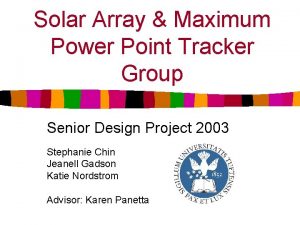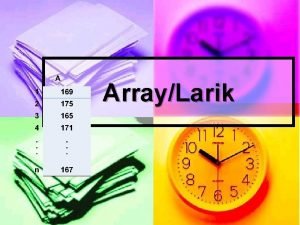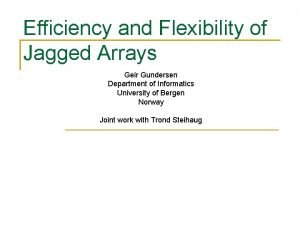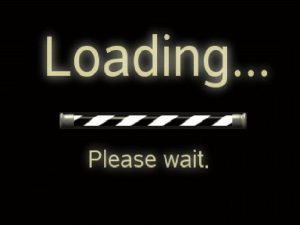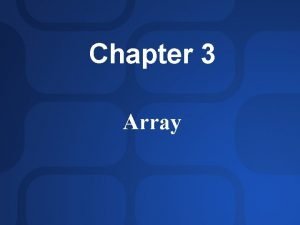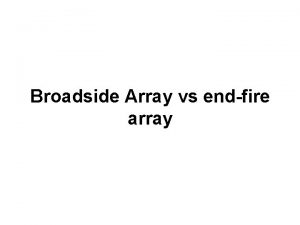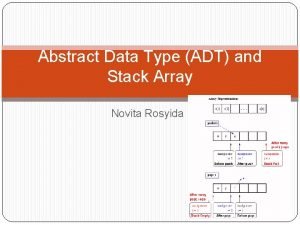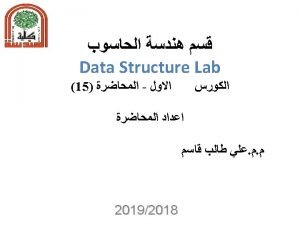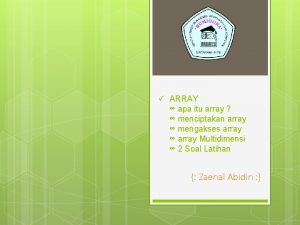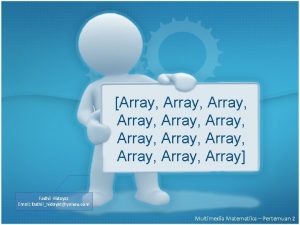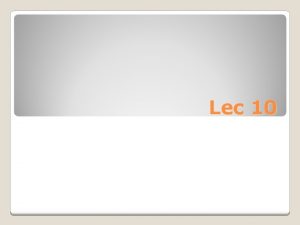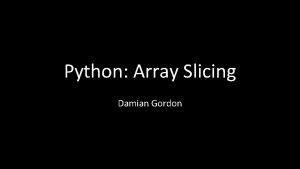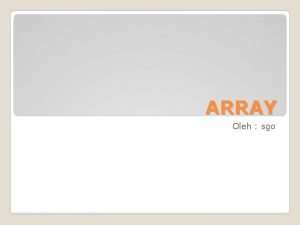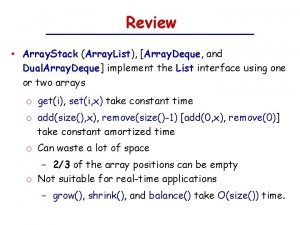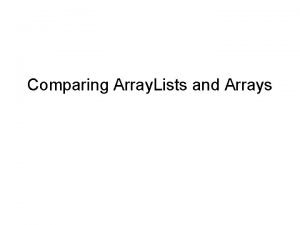OneDimensional Array r A onedimensional array is a






![Computer Main Memory (from lecture 1) If grade[0] starts here . . . 0100101100110101100111000001. Computer Main Memory (from lecture 1) If grade[0] starts here . . . 0100101100110101100111000001.](https://slidetodoc.com/presentation_image_h2/2359916402eae9dfb1cb57b83121874c/image-7.jpg)





- Slides: 12

One-Dimensional Array r A one-dimensional array is a list of variables, all of the same type. l it can be any of the C++ data types or object types l a has a declared length l each variable is identified by a subscript starting with 0 and ending with length -1 l each variable in the list is called an element of the array r Example: int counters[128]; counters 23 -45 [0] [1] 2345 [2] 0 [3] . . . 123 [127] r An array element can be used in a program anywhere a variable can be used. l e. g. , counters[0] = 0; counters[i] = counters[i] + 1; cin >> counters[j]; Computer Science I - Martin Hardwick if (counters[i-2] > 0) {. . . }; Lecture 1 -- 1

For loops and arrays // Initialize counters to 0 for (int k=0; k<128; k++) { counters[k] = 0; } r As always, counter variables should be initialized to 0 before you start counting. r In this case, all 128 elements of the array must be initialized to 0 r The easiest way to do this is with a for loop r In general, you will find for loops very useful when working with arrays. r Note again that the subscript of an array element can be an int variable or an arbitrary expression (as long as it evaluations to an int). Computer Science I - Martin Hardwick Lecture 1 -- 2

Program to initialize an array #include <iostream> using namespace std; int main() { int grades[100]; int i, count; for (i=0; i<100; i++) { cout << "> "; // display a prompt cin >> grades[i]; if (grades[i] < 0) break; } } count = i; cout << count << " grades were entered" << endl; for (i=0; i<count; i++) { cout << "Grade " << i << " is " << grades[i] << endl; } return 0; Computer Science I - Martin Hardwick r Goal: Get a list of grades and print them. r Algorithm: l Read until < 0 entered l Print all the values read r “break” is a statement that we can use to stop a loop early l Works with both FOR and WHILE loops l Useful for the “other conditions” that would otherwise make the condition of the loop unnecessarily complex Lecture 1 -- 3

One-Dimensional Array r Suppose we enter. l >10 l >19 l >7 l >-1 r Result: grades 10 [0] 19 [1] 9 [2] 7 [3] Undef [99] r Undef is the undefined value. l Depending on the compiler and debugger it could be – A strange large negative number – 0 – Something else Computer Science I - Martin Hardwick Lecture 1 -- 4

What type of array r An array can hold many different types of values int grades[10]; string days [7]; double weights [100]; char letters[26]; // would we use this? r There is a special notation for initializing array values using {} int grades[10] = {10, 9, 6, 4, 3, 2, 1, 5, 8, 7}; string days[7] = {“Monday”, “Tuesday”, “Wednesday”. “Thursday”, “Friday”, “Saturday”, “Sunday”}; Computer Science I - Martin Hardwick Lecture 1 -- 5

Common array mistakes r What is the biggest mistake made with arrays? r Letting the code go outside of the bounds grades[10]; int i = 0; i--; grades[i] = 20; // maybe get an error message for (int j = 1; j <= 10; j++) grades[j] = 0; // error at grades[10] r The computer memory is a great big shared resource. r Unless you are lucky going outside the boundary will “trash” the memory of some other variable or code Computer Science I - Martin Hardwick Lecture 1 -- 6
![Computer Main Memory from lecture 1 If grade0 starts here 0100101100110101100111000001 Computer Main Memory (from lecture 1) If grade[0] starts here . . . 0100101100110101100111000001.](https://slidetodoc.com/presentation_image_h2/2359916402eae9dfb1cb57b83121874c/image-7.jpg)
Computer Main Memory (from lecture 1) If grade[0] starts here . . . 0100101100110101100111000001. . . 234 E 16 234 F 16 235016 235116 Then “grade[-1] = 6” will trash four bytes here and If you go a long way outside the bounds e. g grade[-20728291] then you will reach the edge of the memory allowed for your program and there will be a run time error. Computer Science I - Martin Hardwick Lecture 1 -- 7

Using the Visual C++ debugger r There are three things you need to know r How to step through the program using F 10 and F 11 l F 10 executes the next statement l F 11 executes the next statement l But if the next statement is a function F 11 will go into that function and F 10 will stay out and go to the next line of the current function r How to use the big red dot l The big red dot is a break point. You create one by clicking the white space on the left of the code l If you run the program it will run until it reaches the first big red dot and then stop l You can now look at the values of the variables r The point of debugging is to look at the values of the variables l These are shown at the bottom of the screen l There a number of options for viewing and testing values (see the lab notes) Computer Science I - Martin Hardwick Lecture 1 -- 8

Debugging Tips r When using the debugger, as soon as you see something go wrong (i. e. , the wrong value in a variable) stop and try to figure out why. l work backwards through the program line by line to find where the wrong value came from and why l use the debugger for help in determining the values of variables and to evaluate expressions l don’t be afraid to “play computer” using a pencil and paper l think about things like: – how could this result happen? – what sequence of events would have to happen for this result? – which statements could cause this result, which could not? l approach it as you would approach a puzzle to be solved l above all, THINK! r Sometimes, strategically placed cout statements that display the values of variables and expressions can be a big help l use them liberally Computer Science I - Martin Hardwick Lecture 1 -- 9

Program Testing r Don’t assume because your program worked once that it is correct! r Each path through the program must be tested. l each outcome of each IF statement in all combinations r Boundary conditions on input data must be tested. l does it work for all legal input values? l does it work for values at the extremes? l does it correctly catch illegal input values? r You must carefully devise test cases that will test all these aspects of your program. r If you discover a problem that requires changing the program, you must start over with the testing of the program. l making a change to fix one problem can introduce new problems Computer Science I - Martin Hardwick Lecture 1 -- 10

Rules for good programming r Make sure you understand the algorithm before you start l Winging a solution will lead to disaster l Understanding means you should know – What data structures you are going to use – What functions you are going to write – How the “complicated” functions are going to operate r Write neat code that follows the conventions used by programmers l Proper indenting l Good commenting, particularly for function calls, arguments and results l Follow the patterns used by other programmers l Do not let the logic get too complex – 5 levels of identing is about the max – More than this and you should put part of the code in another function r Be defensive l If in doubt run an experiment Computer Science I - Martin Hardwick Lecture 1 -- 11

How to debug r Programmers seem to be divided between those that use the debugger and those that use cout (printf). l Either seems to work well l Cout has an advantage for UNIX debugging l The debugger can help a lot for complex systems on Windows r Try to divide and conquer the problem l Debug the sub-functions first l Test the code to see where values first start to go wrong – Add a cout in the middle – Then add more above or below depending on where the problem seems to be Computer Science I - Martin Hardwick Lecture 1 -- 12
 Photovoltaic array maximum power point tracking array
Photovoltaic array maximum power point tracking array Array dimensi 3
Array dimensi 3 Apa itu menginisialisasi
Apa itu menginisialisasi Jagged array
Jagged array Suatu array dikatakan upper triangular jika
Suatu array dikatakan upper triangular jika Associative array vs indexed array
Associative array vs indexed array Array 2 dimension
Array 2 dimension Pin grid array
Pin grid array Broadside array and endfire array difference
Broadside array and endfire array difference Contoh studi kasus stack
Contoh studi kasus stack Lunar laser ranging retroreflector array
Lunar laser ranging retroreflector array Array adt
Array adt Array element is accessed using
Array element is accessed using
